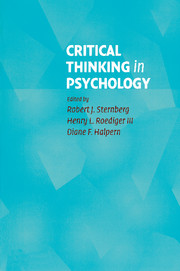Book contents
- Frontmatter
- Contents
- List of Illustrations and Tables
- List of Contributors
- Preface
- 1 The Nature and Nurture of Critical Thinking
- 2 Evaluating Experimental Research
- 3 Critical Thinking in Quasi-Experimentation
- 4 Evaluating Surveys and Questionnaires
- 5 Critical Thinking in Designing and Analyzing Research
- 6 The Case Study Perspective on Psychological Research
- 7 Informal Logical Fallacies
- 8 Designing Studies to Avoid Confounds
- 9 Evaluating Theories
- 10 Not All Experiments Are Created Equal
- 11 Making Claims in Papers and Talks
- 12 Critical Thinking in Clinical Inference
- 13 Evaluating Parapsychological Claims
- 14 Why Would Anyone Do or Believe Such a Thing?
- 15 The Belief Machine
- 16 Critical Thinking and Ethics in Psychology
- 17 Critical Thinking in Psychology
- Author Index
- Subject Index
- References
15 - The Belief Machine
Published online by Cambridge University Press: 05 June 2012
- Frontmatter
- Contents
- List of Illustrations and Tables
- List of Contributors
- Preface
- 1 The Nature and Nurture of Critical Thinking
- 2 Evaluating Experimental Research
- 3 Critical Thinking in Quasi-Experimentation
- 4 Evaluating Surveys and Questionnaires
- 5 Critical Thinking in Designing and Analyzing Research
- 6 The Case Study Perspective on Psychological Research
- 7 Informal Logical Fallacies
- 8 Designing Studies to Avoid Confounds
- 9 Evaluating Theories
- 10 Not All Experiments Are Created Equal
- 11 Making Claims in Papers and Talks
- 12 Critical Thinking in Clinical Inference
- 13 Evaluating Parapsychological Claims
- 14 Why Would Anyone Do or Believe Such a Thing?
- 15 The Belief Machine
- 16 Critical Thinking and Ethics in Psychology
- 17 Critical Thinking in Psychology
- Author Index
- Subject Index
- References
Summary
THE BELIEF MACHINE
Human minds are belief machines. Put raw data into the proper slot and out pops a belief, all polished and ready for action. We believe what we can and give up our beliefs reluctantly. Lest this seem hyperbole, let us observe the belief machine in its purest form – a 3-year-old child. Long before cute little kids can tell right from wrong, illusion from reality, truth from fiction, they believe everything is just what it seems to be – everything is on the level. Parents and, later, schools spend considerable time trying to convince the growing belief machine to modify its input–output routines. We teach children that some things are illusionary, that the truth of important things lies well beneath the surface of sensory experience, and that we should consider before we declare our beliefs.
Fortunately all this effort is often effective, but unfortunately it sometimes is not. The great philosopher-psychologist William James put it most directly: “As a rule we believe as much as we can. We would believe everything if only we could” (James, 1890/1950, p. 299). More recently, Daniel Gilbert (1991) has pointed out even well-educated adults tend to accept what they experience at face value unless they make a deliberate effort to think more deeply about perceived realities. The belief machine can be tweaked and overridden, but it's always on idle waiting to do its thing.
- Type
- Chapter
- Information
- Critical Thinking in Psychology , pp. 251 - 270Publisher: Cambridge University PressPrint publication year: 2006

